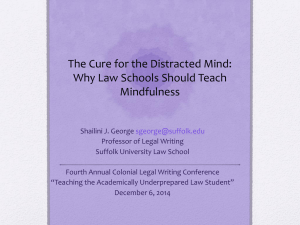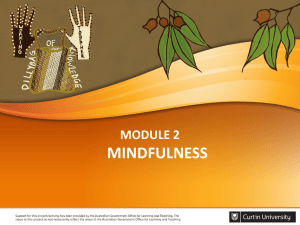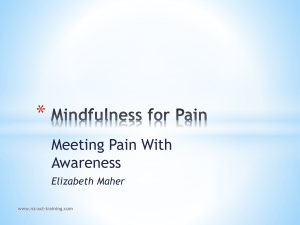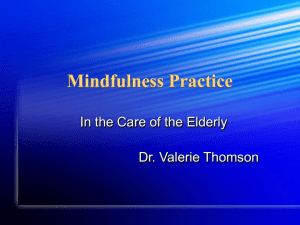Present - University of Pittsburgh
advertisement
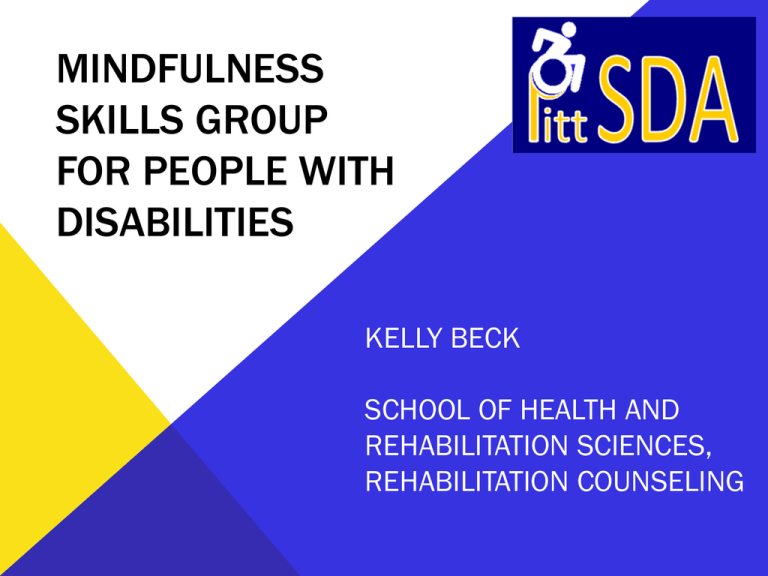
MINDFULNESS SKILLS GROUP FOR PEOPLE WITH DISABILITIES KELLY BECK SCHOOL OF HEALTH AND REHABILITATION SCIENCES, REHABILITATION COUNSELING ACKNOWLEDGEMENTS Support and Collaboration by: University of Pittsburgh, Cognitive Skills Enhancement Program Hiram G. Andrews Center The Albert Schweitzer Fellowship, Pittsburgh The Children’s Institute Three Rivers Center for Independent Living MINDFULNESS “Paying attention on purpose in the present moment, without judgment or reaction to whatever appears in the field of your experience” (Kabat-Zinn, 1985) • Originally a Buddhist principle • Developed into non-religious therapeutic interventions by Jon Kabat-Zinn • Holistic wellness & preventative care • Assisting people in coping with everyday lives and obstacles MINDFULNESS BASED INTERVENTIONS 8-12 weeks group program, 1-3 hours formal per week • Self Reflection • Self-motivated • Non-judgmental, non-reactive • Suspend believing in judgments as being true. • Inherent acceptance of pain and suffering Activities Mind-Body Relaxation • Meditation • Gentle Yoga • Breathing Exercises DISABILITIES & MINDFULNESS BARRIERS OF DISABILITIES More likely to experience…. MINDFULNESS BENEFITS Increased life satisfaction • Unemployment Increased quality of life • Poverty Acceptance of disability • Inadequate healthcare Increased autonomy • Socializing barriers Less anxiety • Less satisfaction with life Strategies for stress management • More stress …..Than people without disabilities CHRONIC PAIN & MINDFULNESS CHRONIC PAIN RESEARCHED MINDFULNESS BENEFITS Low levels life satisfaction Increased life satisfaction Increased stress Increased autonomy & activity Decreased activity Increased community participation Lack of community participation Acceptance of pain Helplessness Pain management techniques Pharmacological side effects Non-pharmacological strategies COGNITIVE DISABILITIES & MINDFULNESS COGNITIVE DISABILITIES RESEARCHED MINDFULNESS BENEFITS Autism Spectrum Disorder Decrease aggressive behaviors Traumatic Brain Injury Regulation of thoughts, emotions, & behaviors Stroke Attention Deficit Hyperactivity Disorder Learning Disability Developmental Delay Cerebral Palsy Spina Bifida Improved attention control Decrease anxiety Improved life satisfaction Improved awareness GROUP DIFFERENCES 15 people, Ages 18-24 80% Caucasian, Male 15 people, Ages 35+ 90% African American, Female Cognitive Disabilities Ages 11-17 90% Caucasian RND Pain Disorders Significant Disabilities Enrolled in cognitive rehabilitation program TRCIL Consumers High IQ, Athletic Dependent on ACCESS Outpatient Voluntary Voluntary, Parental consent Post Secondary Education Attendance Required PURPOSE & GOALS 1. Attention Control 1. Life Satisfaction 1. Awareness of Self 1. Make life more fulfilling 2. Stress Management 1. Awareness of Present 4. Regulation of 4. Socialization Emotions 5. Increase Participation 5. Regulation of thoughts 6. Decreased Stress 6. Decrease Anxiety Levels 1. Life Satisfaction 2. Regulation of Emotions 3. Diaphragmatic Breathing 4. Pain Management 5. Expression of Pain 6. Loving Kindness of Pain CONTENT • Education of attention types • Present Moment Awareness • Non-judgmental • Develop Attention Skills Awareness • Minding your pain • Expression of pain • Diaphragmatic breathing • Mindfulness Awareness • Meditation • Stress Management • Non-judgmental loving kindness • Meditation • Adaptive Yoga • Stress Reduction • Mindfulness Meditation Strategies • Socialization MEASURES Mindfulness Awareness Attention Scale Satisfaction with Life Scale Mindfulness Awareness Attention Scale Satisfaction with Life Scale Perceived Stress Scale Satisfaction with Life Scale State Trait Anxiety Scale Consumer Report and Feedback Perceived Stress Scale Pain Scales CSEP RESEARCH DESIGN • Pre, Post Measures • 12 Week curriculum • Weekly, forty-five minute sessions • Consistent Group Leaders • Weekly homework • Embedded within larger cognitive rehabilitation program • Statistical analyses PRELIMINARY RESULTS CSEP • Statistical analyses and results are pending. • 2 term thesis project. • First term data collected TRCIL • 4/12 group sessions completed • “Does wonders for helping me to learn to be more aware of my body” • “Relieves tension in my body and allowed me to focus on my ‘safe place’-which is my breathing’ • “I nearly slept, which is virtually impossible” The Children’s Institute • Group begins in January, results analyzed by May MINDFULNESS AND DISABILITY • Mindfulness effective and desired across disabilities • Empowerment, advocacy, and preventative health • Embracing disability, mind, body • Health and group socialization benefits FUTURE RESEARCH • Stress and disability • Both environmental stress and disability negatively impact function • Environmental barriers increase stress for those with disabilities • Stress management interventions across disabilities • Funding/Policy changes for environmental stress and disability REFERENCES Bohlmeijer, E., Prenger, R., Taal, E., Cuijper, P., (2010). The effects of miandfulness-based stress reduction therapy on mental health of adults with a chronic medical disease: A meta-analysis. Journal of Psychosomatic Research, 68, 539-544. Dorjee, D. (2010). Kinds and dimensions of mindfulness: Why it is important to distinguish them. Mindfulness, 1, 152-160. Hwang, Y. and Kearney, P., (2013). A systematic review of mindfulness intervention for individuals with developmental disabilities: Long-term practice and long lasting effects. Research in Developmental Disabilities, 34, 314-325. Haydicky, J., Wiener, J., Badali, P., Milligan, K., Ducharme, J. M., et al. (2012). Evaluation of a mindfulness-based intervention for adolescents with learning disabilities and cooccuring ADHD and anxiety. Mindfulness 3, 151-164. Kabat-Zinn, J. (2003). Mindfulness-based stress reduction (MSBR). Constructivism in the Human Sciences, 8:2, 73-83. Kabat-Zinn, J., Lipworth, L., Burney, R. (1985). The clinican use of mindfulness meditation for the self-regulation of chronic pain. Journal of Behavioral Medicine, 8:2, 163-189. REFERENCES Marchard, W. R. (2012). Mindfulness-based stress reduction, mindfulness-based cognitive therapy, and zen meditation for depression, anxiety, pain, and psychological distress. Journal of Psychiatric Practice, 18:4, 233-252. McCown, D., Reibel, D., Micozzi, M. S. (2010). Teaching Mindfulness: A practical guide for educators. New York: Springer. (Introduction Information) clinicians and McMillan, T., Robertson, I. H., Brock, D., Chorlton, L., et al. (2002). Brief mindfulness training for attentional problems after traumatic brain injury: A randomized control treatment trial. Neuropsychological Rehabilitation, 12: 2, 117-125. Miller, J. J., Fletcher, K., Kabat-Zinn, J. (1995). Three year follow-up and clinical implications of a mindfulness meditation-based stress reduction intervention in the treatment of anxiety disorders. General Hospital Psychiatry, 17, 192-200. Paulik, G., Simcocks, A., Weiss, L., Albert, S. (2010). Benefits of a 12-week mindfulness program for mental health consumers in an outpatient setting. Mindfulness, 1, 215-226. group Robertson, B. L. (2011). The adaptation and application of mindfulness-based psychotherapeutic practices for individuals with intellectual disabilities. Fletcher, R., J. (Ed), Psychotherapy for individuals with intellectual disability (pp. 91-106). New York: NADD. Singh, N., Lancioni, G., Manikam, R., Winton, A., Singh, A., Singh, J., Singh, A. D., (2011). A mindfulnessbased strategy for self-management of aggressive behavior in adolescents with autism. Research in Autism Spectrum Disorders, 5, 1153-1158. Zylowska, L., Ackerman, D., Yang, M., Futrell, J., Horton, N., Sigi Hale, T., Pataki, C., Smalley, Journal of Attention Disorders, 11, 737-746. S. (2008).
